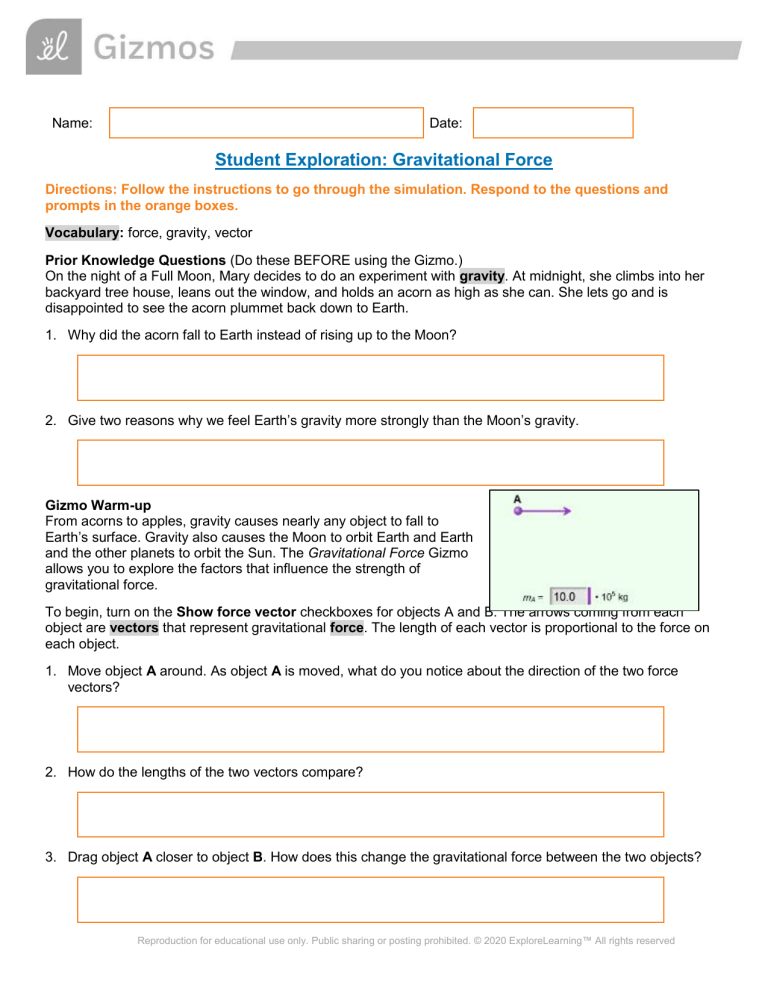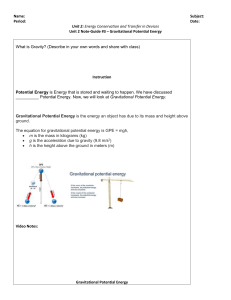
Name: Date: Student Exploration: Gravitational Force Directions: Follow the instructions to go through the simulation. Respond to the questions and prompts in the orange boxes. Vocabulary: force, gravity, vector Prior Knowledge Questions (Do these BEFORE using the Gizmo.) On the night of a Full Moon, Mary decides to do an experiment with gravity. At midnight, she climbs into her backyard tree house, leans out the window, and holds an acorn as high as she can. She lets go and is disappointed to see the acorn plummet back down to Earth. 1. Why did the acorn fall to Earth instead of rising up to the Moon? 2. Give two reasons why we feel Earth’s gravity more strongly than the Moon’s gravity. Gizmo Warm-up From acorns to apples, gravity causes nearly any object to fall to Earth’s surface. Gravity also causes the Moon to orbit Earth and Earth and the other planets to orbit the Sun. The Gravitational Force Gizmo allows you to explore the factors that influence the strength of gravitational force. To begin, turn on the Show force vector checkboxes for objects A and B. The arrows coming from each object are vectors that represent gravitational force. The length of each vector is proportional to the force on each object. 1. Move object A around. As object A is moved, what do you notice about the direction of the two force vectors? 2. How do the lengths of the two vectors compare? 3. Drag object A closer to object B. How does this change the gravitational force between the two objects? Reproduction for educational use only. Public sharing or posting prohibited. © 2020 ExploreLearning™ All rights reserved Get the Gizmo ready: Activity A: Gravity and mass ● Turn on Show vector notation for each object. ● Check that each object’s mass (mA and mB) is set to 10.0 • 105 kg. Question: How does mass affect the strength of gravitational force? 1. Form hypothesis: How do you think the masses of objects A and B will affect the strength of the gravitational force between them? 2. Predict: How do you think the gravitational force between two objects will change if the mass of each object is doubled? 3. Measure: Turn on Show grid. Place object A on the x axis at -20 and object B on the x axis at 20. The force on object A is now 0.0417i + 0j N. That means that the force is 0.0417 newtons in the x direction (east) and 0.0 newtons in the y direction (north). A. What is the magnitude of the force on object A? |FA| = B. What is the magnitude of the force on object B? |FB| = 4. Gather data: You can change the mass of each object by clicking in the text boxes. For each mass combination listed in the table below, write magnitude of the force on object A. Leave the last two columns of the table blank for now. mA (kg) mB (kg) 10.0 • 105 kg 10.0 • 105 kg 10.0 • 105 kg 20.0 • 105 kg 20.0 • 105 kg 20.0 • 105 kg 20.0 • 105 kg 30.0 • 105 kg |FA| (N) Force factor mA • mB (kg2) 5. Calculate: To determine how much the force is multiplied, divide each force by the first value, 0.0417 N. Round each value the nearest whole number and record in the “Force factor” column. Next, calculate the product of each pair of masses. Fill in these values in the last column. Compare these numbers to the “Force factor” numbers. 6. Analyze: How much does the force increase if each mass is doubled? Reproduction for educational use only. Public sharing or posting prohibited. © 2020 ExploreLearning™ All rights reserved 7. Analyze: How do the force factors compare to the products of the masses? 8. Apply: What would you expect the force to be if the mass of object A was 50.0 • 105 kg and the mass of object B was 40.0 • 105 kg? Check your answer with the Gizmo. 9. Draw conclusions: How do the masses of objects affect the strength of gravitational force? 10. Summarize: Fill in the blank: The gravitational force between two objects is proportional to the of the masses of the objects. 11. Apply: Suppose an elephant has a mass of 1,800 kg and a person has a mass of 75 kg. If the strength of gravitational force on the person was 735 N, what would be the gravitational force on the elephant? (Assume both the person and elephant are on Earth’s surface.) ✏️ Show your work: Reproduction for educational use only. Public sharing or posting prohibited. © 2020 ExploreLearning™ All rights reserved Activity B: Get the Gizmo ready: ● Turn on Show distance. ● Set mA and mB to 10.0 • 105 kg. Gravity and distance Question: How does distance affect the strength of gravitational force? 1. Form hypothesis: How do you think the distance between objects A and B will affect the strength of the gravitational force between them? 2. Predict: How do you think the gravitational force between two objects will change if the distance between the objects is doubled? 3. Measure: Place object A on the x axis at -5 and object B on the x axis at 5. A. What is the distance between the two objects? B. What is the magnitude of the force on object A? |FA| = 4. Gather data: For each set of locations listed below, record the distance and the force on object A. Leave the last two columns blank for now. Object A Object B (-5, 0) (5, 0) (-10, 0) (10, 0) (-15, 0) (15, 0) (-20, 0) (20, 0) Distance (m) |FA| (N) Force factor 1 Distance2 5. Interpret: How does increasing the distance affect the force? 6. Calculate: To calculate the force factor, divide each force by the original force (0.667 N). Write each force factor with three significant digits. Next, calculate the reciprocal of the square of each distance and fill in the last column of the table. Write each of these values with three significant digits as well. (The unit of 1/distance 2 is square meters, or m2.) Reproduction for educational use only. Public sharing or posting prohibited. © 2020 ExploreLearning™ All rights reserved 7. Analyze: Compare the force factors to the 1/distance2 values in your table. What is the relationship between these values? 8. Apply: What would you expect the force to be if the distance was 50 meters? Use the Gizmo to check your answer. 9. Make a rule: Based on the measured force between objects that are 10 meters apart, how can you find the force between objects that are any distance apart? 10. Summarize: Fill in the blanks: The gravitational force between two objects is proportional to the of the distance 11. Challenge: In activity A, you found that the gravitational force between two objects is proportional to the product of their masses. Combine that with what you have learned in this activity to complete the universal formula for the force of gravity below. (Hint: In the equation, G is a constant.) Check your answer with your teacher. 12. On your own: Use the Gizmo to find the value of G in the formula above. List the value and describe how you found it below. The units of G are newton · meter2 ÷ kilograms2, or N·m2/kg2. Check your answer with your teacher. G= ✏️ Show your work: Reproduction for educational use only. Public sharing or posting prohibited. © 2020 ExploreLearning™ All rights reserved





